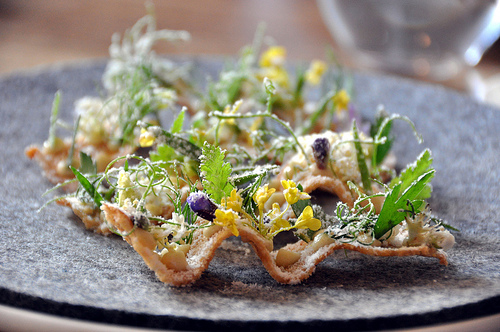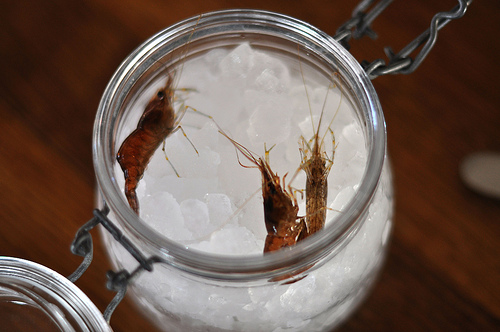The day, like many winter days in Copenhagen, was chilly, gray, and drizzly. That didn’t discourage my friends and me on a recent trip to Denmark as we took a long walk across the city. We were on our way to Noma–named three times the Best Restaurant in the World by Restaurant magazine. The small restaurant–only 11 tables—is in a simple stone building, located in an abandoned warehouse in the city’s harbor district. In the weak light of winter, the light outside the restaurant door looked inviting even at mid-day. We were greeted at the door by an apron-clad server. When I told him how excited we were about the meal, he said, “You should be. Come right on in, we are ready for you.”
Tundra moss, razor clams and flying shrimp
And so began a four-hour feast of twenty dishes at the edge of the culinary frontier. The menu was set by the restaurant with options for those who didn’t want meat or dairy. Some of the dishes were based on items that I don’t ordinarily consider food–ants, grasshoppers, and tundra moss. Others were based on foods rendered into shapes and textures I’d never seen or even imagined, for example, amber ultra-thin slices of scallop served with beechnut, einkorn and watercress.
No dish tasted like anything I have ever encountered before…but (almost) every one was delicious.
The tundra moss was presented as a small lacey brick that looked like it would be chewy and tasteless, but instead melted in my mouth and burst into delicate, savory explosion of flavor.
Then there were razor clams served with horseradish, the oysters with gooseberry and buttermilk, and on and on. All accompanied by excellent local bread and butter.
The experience was not without humor. In the midst of dinner, the server placed on the table a clear, lidded jar full of ice, and described it with a flourish as ‘fresh shrimp.” I could not resist the temptation, and opened the jar, only to have one of the shrimp jump out in the direction of one of my dining companions, who let out a small shriek of surprise.
The shrimp were intended to be consumed alive, a big challenge after one looked at their long, twitching legs. I declined this particular culinary adventure, but one of my companions bravely downed a wriggling creature whole. My other companions consumed the shrimp after they had been cut in half and rendered motionless. Later on, we heard eruptions of laughter at other tables in the restaurant and knew they had just discovered the shrimp.
Although I had passed on shrimp, I was willing to try the ants and blueberries, a dish containing tasty, but thankfully unrecognizable, ants.
Embracing place-based eating
The chef at the helm of this fabulous experience is Rene Redzepi, whose career might be summed up as a response to one of the biggest challenge of place-based eating—the place. Easy enough to find local and regional foods in France or Italy, one might say, but Denmark? After the seafood, the pork and the dairy cows, the Nordic larder seems pretty spare. How could one fashion a cuisine based on Nordic foods? The answer is with the creativity, imagination and extraordinary culinary skill. (For a brief introduction to Redzepi and his spectacular food, check out the video on Amazon.)
Creating a Nordic cuisine from scratch is hard work. Noma keeps two chefs working full time testing new ideas, many of which come from the Noma staff. And it’s daring. Ants and moss are not for everyone.
But place-based eating is a challenge that is being embraced by people far from the world of fancy restaurants all over the the world. People from chefs to home cooks are looking anew at the opportunities for food close to home.
Not every one will want to have the Noma experience. Ants do have their limits. But it is inspiring to know that food horizons are not as limited as we think…and that the sustainable agriculture movement has a forward-leaning edge among the some of the world’s most creative chefs.
Refocusing food on place is an exciting idea. Place-based eating, if not carried too far—yes, Noma serves coffee, tea and wine–offers new economic opportunities for sustainable farmers and food producers, new connections to friends and neighbors, and new kinds of delicious foods. That’s something we can all embrace.


